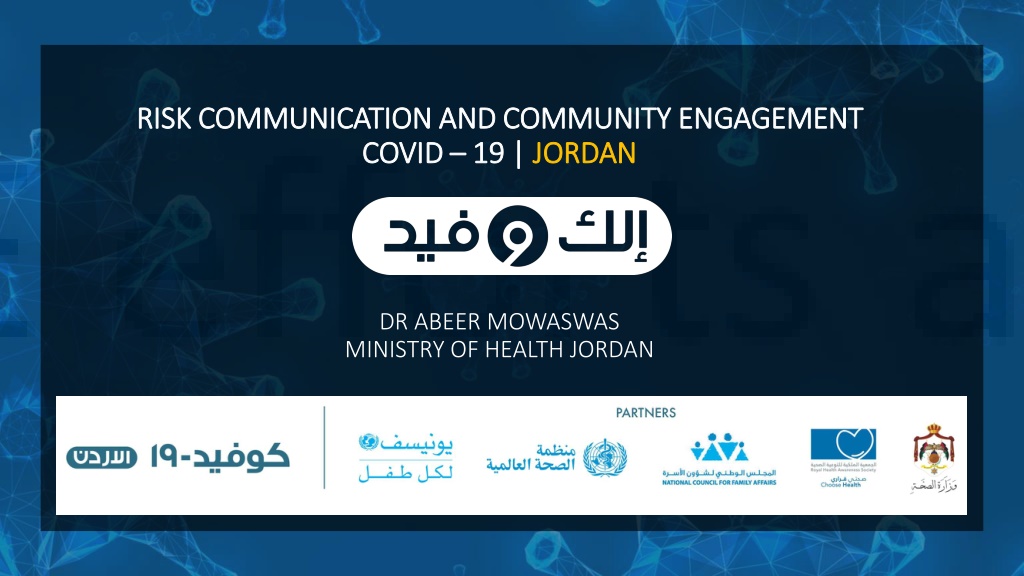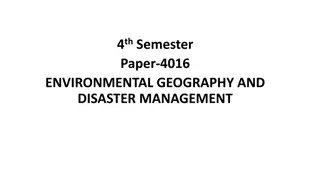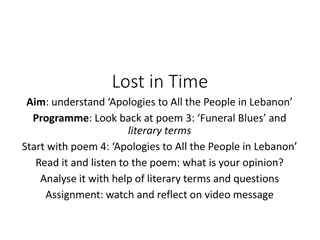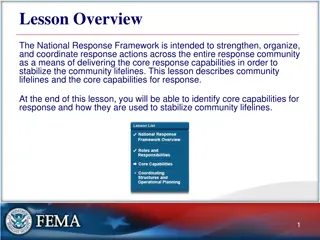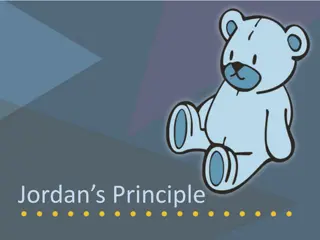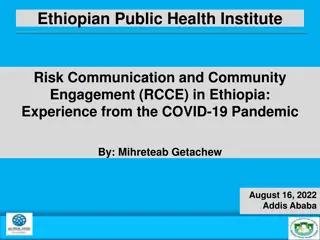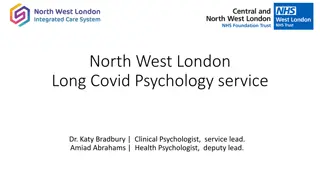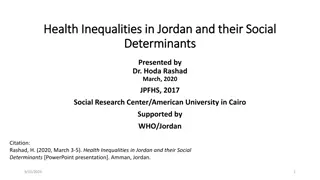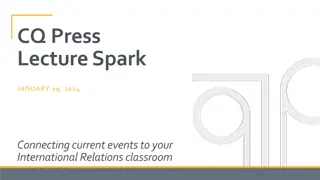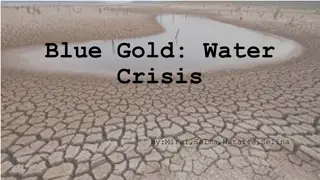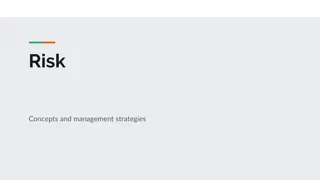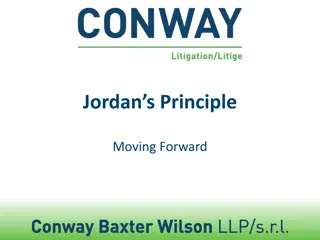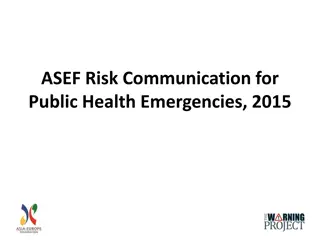Risk Communication and Community Engagement in Jordan's COVID-19 Response
Risk Communication and Community Engagement (RCCE) efforts in Jordan prioritize collaboration to disseminate accurate information, counter misinformation, and promote behavior change. Partners include the Ministry of Health, UNICEF, WHO, and others, reaching millions with key messages and interventions. Evidence generation through surveys, discussions, and observations forms the basis of RCCE strategies. Community listening tools and studies conducted in the past year further inform national campaigns to address COVID-19 perceptions and behaviors.
Download Presentation

Please find below an Image/Link to download the presentation.
The content on the website is provided AS IS for your information and personal use only. It may not be sold, licensed, or shared on other websites without obtaining consent from the author. Download presentation by click this link. If you encounter any issues during the download, it is possible that the publisher has removed the file from their server.
E N D
Presentation Transcript
RISK COMMUNICATION AND COMMUNITY ENGAGEMENT RISK COMMUNICATION AND COMMUNITY ENGAGEMENT COVID COVID 19 19 | | JORDAN JORDAN DR ABEER MOWASWAS MINISTRY OF HEALTH JORDAN
RISK COMMUNICATION AND COMMUNITY ENGAGEMENT RISK COMMUNICATION AND COMMUNITY ENGAGEMENT COVID-19 RCCE response in Jordan prioritised strong collaboration with partners and stakeholders to increase the effectiveness of its interventions. Together with the Ministry of Health, UNICEF, WHO, NCFA and RHAS, along with other 28 partners, the national covid-19 campaign (Elak o Feed) disseminated key messages from one trusted source of information to counter misinformation and to maintain public knowledge and trust in relation to both COVID-19 and the COVID-19 vaccine across all communities in Jordan, and allowed for substantial behaviour change to help reduce the spread of COVID-19. 5-7 million people reached / monthly (70% of the population) 300,000 3 million people engaged in monthly Integrated Nationally-led Community- centered Participatory Coordinated Inclusive
EVIDENCE GENERATION: EVIDENCE GENERATION: FORMED THE BASIS OF RCCE INTERVENTIONS FORMED THE BASIS OF RCCE INTERVENTIONS To target and address misconception and rumors To provide timely messages to the community to fill knowledge gaps To identify gaps in existing interventions and find solutions to address them To advocate on behalf of the community Quantitative and Qualitative surveys Quantitative and Qualitative surveys Focus Groups Discussions (FGD) Focus Groups Discussions (FGD) Observations Observations Online community mapping Online community mapping
SIX STUDIES CONDUCTED LAST YEAR (MAR 2020 MAR 2021)
NATIONAL RCCE CAMPAIGN BASELINE SURVEY NATIONAL RCCE CAMPAIGN BASELINE SURVEY JAN Qualitative Study on covid-19 in general conducted with 1,004 participants (60% female and 40% male) from 12 governorates key findings below: JAN 2021 2021 How often do you practice the following behaviors: 100% 80% 52.7% 54.5% 65.7% 68.2% 68.5% 75.8% 60% 82.5% 83.7% 84.1% 89.8% 40% 40.1% 39.6% 20% 30.4% 25.9% 27.3% 21.4% 15.5% 13.5% 14.7% 8.9% 7.1% 5.9% 5.7% 4.4% 3.8% 2.8% Female 2.7% Male 2.0% Male 1.3% Female 1.2% Female 0% Female Male Female Male Male Wearing face masks Practicing social distancing at home and in the workplace Avoiding the physical contact (handshaking, kissing, eating food handed by someone) Washing hands with soap and water, or using alcohol-based hand Avoiding crowded areas and adhering to physical distancing in public areas Never Sometimes Always 84% said that they would seek the coronavirus test (PCR) if they felt unwell or showed coronavirus related symptoms; however, 11% said they would not undergo the test; and 5% don't know whether they would do it or not. 91% said that they encounter challenges in protecting themselves and their families from coronavirus. 57% of the respondents found the lack of adherence from people in institutions and public places as the main challenge; 42% noted the 'financial barriers , while 33% see the social obligations as barriers.
Important finding to note: the behavioral impact of covid Important finding to note: the behavioral impact of covid- -19 social and cultural customs and traditions practice in Jordan social and cultural customs and traditions practice in Jordan 19 on on Comparison of precautionary behaviors during and after COVID-19 100% 87.4% 79.8% 80% 72.6% 61.4% 60% 54.3% 51.0% 44.3% 41.5% 40.1% 39.2% 40% 35.3% 35.1% 20% 15.2% 4.0% 0% Greeting people (kissing and handshaking) Going to the crowded areas Physical contact, especially with Eating food handed by someone else Sharing the personal household utensils with other people Smoking and shisha in the public areas Don't know elderlies During the pandemic After the pandemic
FOCUS GROUP DISCUSSION FOCUS GROUP DISCUSSION Jan conducted with youth (6), 5 women CBOs, doctors (13) and nurses (5), to map the acceptance of COVID-19 vaccine. Key findings below Jan 2021 2021 Few comments from FGD . - If sufficient and trusted information will be provided about the vaccine, then I could be convinced and convince people accordingly. At this moment, I wouldn t encourage others to take the vaccine because I don t know its ingredients and side effects. Student- Prince Tharwat College Nurses and Youth showed more hesitancy; they don t trust/were unsure of the vaccine's effectiveness due to lack of information available, the side effects and the conflicting opinions about the two vaccines on social media. . - I heard that Pfizer has immunity, if anyone had side effects due to taking the vaccine, they won t be responsible for that. I m not convinced of the American vaccine to be convinced about the Chinese one! Nurse- MoH Health Center " For private and public sector doctors, all of them are willing to take the vaccine. Nurses, along with the youth and women CBOs prefer to see others experience with the vaccine before making a sound decision. % 40/45 - I m completely convinced about the vaccine. Actually, there are no sufficient studies about it, but it s promising to have the vaccine now. if it provides a percentage of 40-45% of protection this is an excellent achievement GP Doctor- private-sector
VACCINE ACCEPTANCE SURVEY VACCINE ACCEPTANCE SURVEY Dec Qualitative Study conducted with 15,099 participants (44.4% female and 55.6% male, < <20 from 12 governorates key findings below: Dec 2020 2020 20 to > to >60 60age age) For general audience, the side effects was the main cause for hesitation in all age groups. Access to vaccine was not seen as a cause of hesitation by the participants in the above 60 age group, more than 45% stated side effects as a cause for hesitation in taking the vaccine, more than 25% cited lack of evidence on vaccine effectiveness as a cause for hesitation Even with approvals from authorities, a lot of hesitancy seen in all age groups, especially amongst the younger health workers More hesitation seen in males (the vulnerable gender as noted in the audience profile of covid-19 cases in Jordan)
NATIONAL RCCE CAMPAIGN BASELINE SURVEY NATIONAL RCCE CAMPAIGN BASELINE SURVEY April focused on the level of awareness and behavioral impact level of awareness and behavioral impact of covid-19 on the community. The target population were internet/social media users between the ages of 18 and 45 from 12 governorates (1,042 respondents (813 female and 229 male)). Key findings below: April 2020 2020 67% of the respondents felt that they had increased knowledge of COVID-19 compared to one month ago when the RCCE efforts commenced. More than 90% of the respondents felt that their current knowledge level was either above average or excellent compared to only 50% which felt so a month ago. The majority of the respondents reported practicing recommended prevention behaviors such as hand-washing and social distancing.
NATIONAL RCCE CAMPAIGN BASELINE SURVEY NATIONAL RCCE CAMPAIGN BASELINE SURVEY Batch focused on the the behavioral impact and questions pertaining to norms, attitudes, and concerns behavioral impact and questions pertaining to norms, attitudes, and concerns of covid-19 on the community. The target population were internet/social media users between the ages of 18 and 45 from 12 governorates (634 respondents (376 female and 258 male)). Key findings below: Batch 2 2 April April 2020 2020 More than half (56%) of the respondents (61% of female and 49% of male respondents) were concerned that people they know will be infected with the virus. Overall, the respondents were more concerned about other people getting infected (56%) than they are about themselves getting infected (25%). The respondents showed high level of concern that their parents will be infected with COVID-19. More than two- thirds (63%) of the respondents (68% of female and 55% of male respondents) recorded that they are concerned that their parents will be infected
OBSERVATIONS (ONGOING) OBSERVATIONS (ONGOING) On a daily basis, the campaign is tracking trending topics/issues and mapping to be able to timely respond to those questions/comments/queries to fill any knowledge gaps and challenges. Concerns noted presently: The delay in receiving the result of PCR has lead to increase of cases as people don t stay home unless they get a confirmation they are infected (which usually it takes 3-4 days to get the result after the test) People do no go for testing as they are afraid if they end up covid-19 positive, they might lose their jobs due to quarantine and their children/family will be asked to stay home as well and don t go to schools People don t go for testing as they don t want to be recognized by MOH as patient and forced to stay home Increase in demand and complains about the shortage of vaccine Side effects of the vaccine: lots of negative rumors and misinformation on social media
ONLINE COMMUNITY MAPPING (ONGOING) ONLINE COMMUNITY MAPPING (ONGOING) Queries noted presently: What are the side effects of the vaccine? How effective is the vaccine? (What is the duration that it will protect your from covid-19?, is it effective ? Can I get vaccine from private sector?) If we take the vaccine, why do we have to wear a mask still? Do we have the option to select the type of vaccine? Will the vaccination be compulsory? Physical distancing is not effective as most of transmission happens inside home Concerns noted presently: People registering on the vaccine platform are not receiving responses or appointments. People vaccinated are not following the precautionary measures (considering themselves safe).
STRATEGY FOR STRATEGY FOR 2021 2021 Moving forward from the directive, one-way communication towards the community engagement and participatory approaches in an aim to increase trust and social cohesion, and ultimately reduce the negative impacts of COVID-19. Focus is on more people-centered and community led initiatives to re-emphasize key messages on health practices and inform the community to increase vaccine uptake: Examples of interventions done in Jan and Feb 2021: Training for frontline workers (community and health) on the basic knowledge on Covid-19 prevention measures, concepts and skills of community engagement to support in active listening and responding to the community with key messages to increase vaccine uptake and adherence to healthy practices. Mobilizing youth, in coordination with Ministry of youth, to act as positive influencers in the community Mobilizing artists and influencers, in coordination with Ministry of culture
THANK YOU. THANK YOU.
